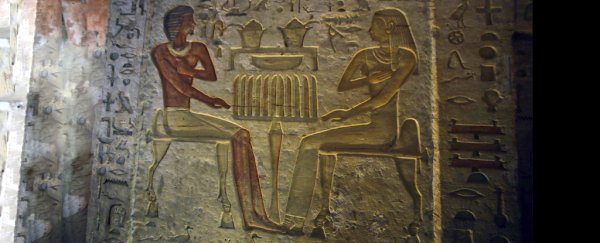A newly discovered, well-preserved tomb in Egypt has been determined to be the final resting place of a royal priest who, according to one excavation official, really loved his mom.
"He mentions the name of his mother almost everywhere here," said Mostafa Waziri, secretary general of the Supreme Council of Antiquities, pointing to the dozens of hieroglyphics, statues and drawings.
Photos and videos of the tomb, which is more than 4,000 years old, show its exceptional condition. Waziri said the find was "one of a kind in the last decades," according to Reuters.
#New #discovery #Saqqara #necropolis #tomb of the #royal #purification #Priest #fifthdynasty #king #neferirkare #Egypt pic.twitter.com/qnPJJuuPcl
— Ministry of Tourism and Antiquities (@TourismandAntiq) December 15, 2018
The priest's name is Wahtye, who served during Egypt's Fifth Dynasty under King Neferirkare, according to Waziri. His tomb is about 33 feet long, 10 feet wide and 10 feet high, and was uncovered in the Saqqara region, which is south of Cairo.
It contains two levels filled with dozens of statues and colorful drawings of the priest and his family.
Various drawings depict "the manufacturing of pottery and wine, making religious offering, musical performances, boats sailing, the manufacturing of the funerary furniture, and hunting," according to Egypt Today.
NPR reports the Saqqara site is part of a larger complex where archaeologists have discovered art and architecture that provide insight into the daily life in ancient Egypt.
Many other ancient artifacts probably remain hidden in the tomb's lower depths, Waziri said. He pointed toward a shaft that he believes contains a sarcophagus of the tomb's owner, in addition to many other objects.
"We're gonna start, the day after tomorrow, digging to reveal what kind of secrets this shaft is hiding," he said. Further excavation is expected to begin Sunday.
"The color is almost intact even though the tomb is almost 4,400 years old," he said, according to Reuters. Egypt's Fifth Dynasty ruled from about 2,500 BC to 2,350 BC.
More photos of the tomb are below:
 A view of the tomb's wall. (Mohamed Abd El Ghany/Reuters)
A view of the tomb's wall. (Mohamed Abd El Ghany/Reuters)
 An archaeological worker stands inside the tomb. (Mohamed Abd El Ghany/Reuters)
An archaeological worker stands inside the tomb. (Mohamed Abd El Ghany/Reuters)
 Statues inside the tomb of Wahtye. (Mohamed Abd El Ghany/Reuters)
Statues inside the tomb of Wahtye. (Mohamed Abd El Ghany/Reuters)
 Statues inside the tomb of Wahtye. (Khaled Elfiqi/EPA-EFE/REX)
Statues inside the tomb of Wahtye. (Khaled Elfiqi/EPA-EFE/REX) The tomb of Wahtye dates to the reign of King Neferirkare. (Mohamed Abd El Ghany/Reuters)
The tomb of Wahtye dates to the reign of King Neferirkare. (Mohamed Abd El Ghany/Reuters)
 Statues inside the tomb of Wahtye. (Mohamed Abd El Ghany/Reuters)
Statues inside the tomb of Wahtye. (Mohamed Abd El Ghany/Reuters)
 A statue inside the tomb of Wahtye. (Mohamed Abd El Ghany/Reuters)
A statue inside the tomb of Wahtye. (Mohamed Abd El Ghany/Reuters)
 A view of the tomb's entrance. (Khaled Desouki/AFP/Getty Images)
A view of the tomb's entrance. (Khaled Desouki/AFP/Getty Images)
Archaeologists will continue to excavate Wahtye's tomb and expect to make more discoveries soon, Waziri said.
2018 © The Washington Post
This article was originally published by The Washington Post.
